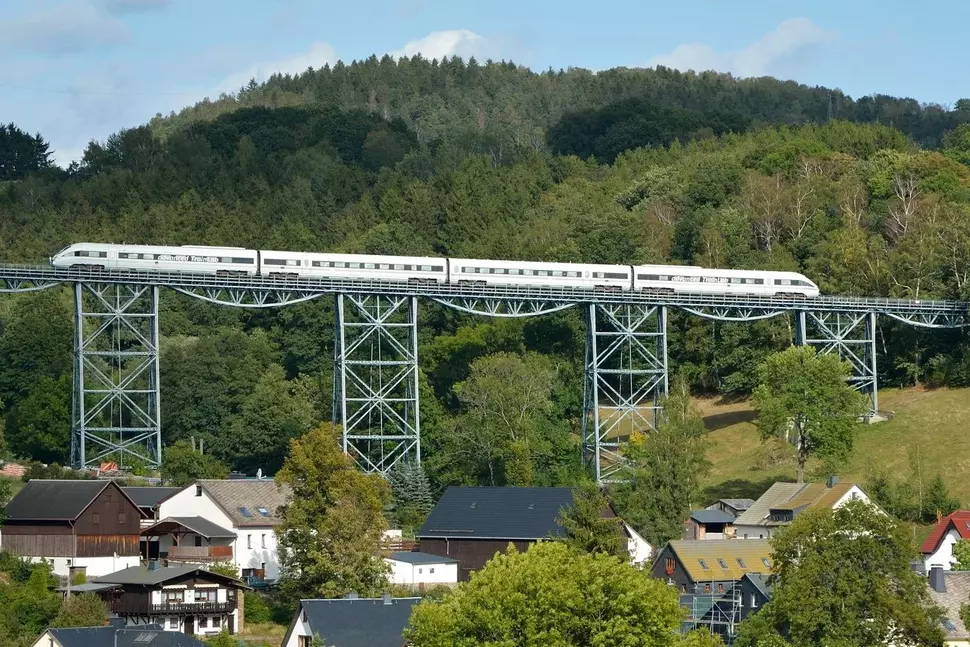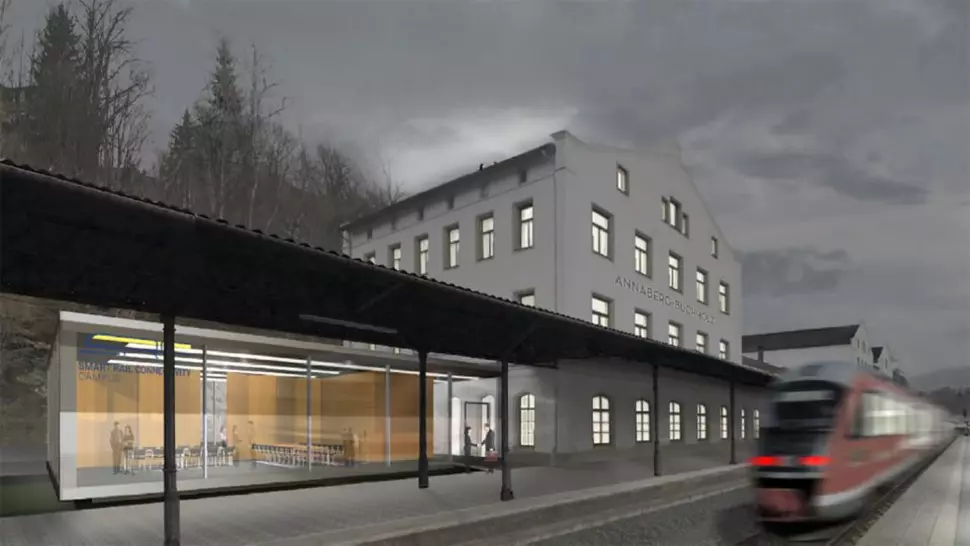Rail Transport’s Future Is Found in the Erzgebirge Mountains
The Smart Rail Connectivity Campus (SRCC), the only one of its kind in Europe, pools the expertise of over 150 partners to test highly automated driving on standard gauge. 2019 saw the world's first driverless train run in the Erzgebirge Mountains.

Whenever the European rail industry wants to research and test the latest developments in the rail transport of the future, then the industry comes increasingly to Annaberg-Buchholz in Saxony’s Erzgebirge Mountains. It is here where the Smart Rail Connectivity Campus, abbreviated SRCC and operated by the DB RegioNetz Erzgebirgsbahn corporation, is evolving into one of Europe’s largest digital test fields for intelligent rail transport. The campus is also one of four nationwide locations of the German Center for Future Mobility (DZM).
Smart Rail Connectivity Campus (SRCC)150 Partners Drive Digitalization on the Railways
In 2018, partners from Saxony’s industrial and scientific communities manifested their idea of continuing and intensifying the existing cooperation in research projects by putting it on a more permanent basis and a larger scale. Towards this end, the city and region of Annaberg-Buchholz quickly moved into their focus. Here, Europe’s first digital signaling facility at the rail station Annaberg-Buchholz Süd – also operated by DB RegioNetz Erzgebirgsbahn – as well as the branch line between Annaberg-Buchholz and Schwarzenberg, which is primarily used by tourists, provide the best possible prerequisites for developing and testing the future of digitalized automated rail transport. With its winding and mountainous topography, the 25 kilometer (i.e. 15.5 mile) stretch has all kinds of rail line profiles which is why it is ideally suited as a test track. In addition, the City of Annaberg-Buchholz has actively promoted the project right from the start – together with the other initiators, Chemnitz University of Technology (TU Chemnitz) and – as a part of DB RegioNetz – the Erzgebirgsbahn railroad company.
Today, about 150 partners are united under the roof of the SRCC and include leading companies from the European rail industry as well as other international, national, and regional enterprises, research institutions, municipalities, and organizations. They all share the objective of establishing an agile innovation and network platform for the research, development, prototyping, and qualification for the approval of the rail transport of the future. At the same time, the project links partners of different sizes, with different orientations and competences in a regional innovation network of a new quality which seeks to make a decisive contribution towards a successful structural change in the Erzgebirge Mountains initially in the smart rail innovation field and, in the future, also in additional fields of innovation.

Attractive Campus
The SRCC headquarters are located at the Unterer Bahnhof rail station in Annaberg-Buchholz. The station building which is no longer in use is undergoing extensive renovation and gradually turning into a modern research campus. Chemnitz University of Technology (TU Chemnitz) has already established a branch office here. The Austrian rail sensor technology specialist Frauscher has moved in as well and operates a development center from the Erzgebirge Mountains. In a second construction phase, a training and education center will be built for the Deutsche Bahn which conducts extensive field tests in the Erzgebirge Mountains within the scope of its “Digital Rail Germany” initiative. A third construction phase includes the establishment of an innovation and founder center as well as a research hall with state-of-the-art equipment, for example, for the preparation of track tests.
World Premiere for Driverless Trains
An essential prerequisite for the development and testing of the intelligent rail transport of the future is currently under construction. With the establishment of a 5G infrastructure along the test track as well as an independent 5G campus network, the SRCC possesses one of the most comprehensive digital test fields in all of Europe where the elements of a safe and secure, automated and integrated rail traffic can be put to the test.
Already prior to the final completion of the 5G infrastructure, the SRCC stakeholders introduced a world premiere: For the first time ever in September 2019, a driverless research train ran on the test track, remotely controlled through 5G, from a control station along the track. Another milestone was set in November 2022. This time, the train was successfully steered from the Institute of Transportation Systems at the German Aerospace Center (DLR) – an important partner of the SRCC – which is located 340 kilometers (i.e. 211 miles) away. 5G technology and in the future also 6G technology will permit many additional trial runs, tests, and developments to implement a safe and secure, automated rail transport through high-performance, trouble-free real-time communication between trains and the infrastructure.
The First 50-Hertz Recharging Station for Battery-Powered Trains
The rail transport of the future is to travel not only reliably digitalized, but also emission-free. For this as well, the SRCC is laying down the tracks. Under its direction, Europe’s first 50-hertz recharging station with symmetric converter for battery-powered trains was built at the rail station Annaberg-Buchholz Süd. After a one-year test period, battery-powered trains will travel between Leipzig and Chemnitz and, in part, all the way to Annaberg-Buchholz as of 2024 whereby these trains can be recharged at the rail station Annaberg-Buchholz Süd.
Numerous other projects are underway within and outside the “WIR! – Change through Innovation in the Region” program funded by the Federal Ministry of Education and Research (BMBF). These projects revolve around those fields of technology which the SRCC stakeholders have identified as being essential for sustainable rail transport and in the same way also for intermodal mobility. This includes data analysis and AI, sensor technology, communication technology, control and safety technology, drive and energy technology as well as human-technology interaction. One of the projects focuses on the development of an energy management system for hydrogen-powered trains which, by interacting with driver assistance systems, permits the optimal interaction of different drive and propulsion components.

Young Ambassadors Raise Enthusiasm for the SRCC
In addition to various technically focused topics, general and continued education and training is another important field of action in the SRCC. With diverse qualification offers, the stakeholders do not just start with apprentices, experienced professionals, or career changers. They have attracted child ambassadors who, for example, explain in entertaining videos what is happening on the Smart Rail Connectivity Campus. The 7- to 14-year-old girls and boys have lots of fun doing so, discover many a career wish for themselves, and inspire others – whether it be children of the same age or adults – with their enthusiasm.